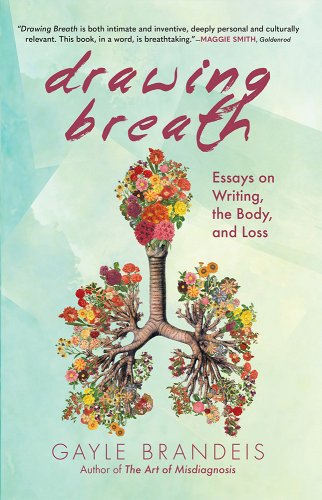Reviewed by Diane Gottlieb
How much time do you spend pondering your breath? Maybe a lot if you meditate or practice yoga. Probably quite a bit when your sinuses are clogged or if your respiratory system is compromised. Otherwise though, breath, is not something most people think about very often. It’s automatic. A regular, automatic miracle.
 Gayle Brandeis’s Drawing Breath: Essays on Writing, the Body, and Loss (Overcup Press; Feb. 2023) is full of small miracles, although there’s nothing automatic about her writing. Brandeis’s essays are well thought-out, beautifully constructed, and truly labors of love. The reader senses a deep respect in each piece for hard-earned growth—and for growing pains.
Gayle Brandeis’s Drawing Breath: Essays on Writing, the Body, and Loss (Overcup Press; Feb. 2023) is full of small miracles, although there’s nothing automatic about her writing. Brandeis’s essays are well thought-out, beautifully constructed, and truly labors of love. The reader senses a deep respect in each piece for hard-earned growth—and for growing pains.
Brandeis organizes her essays by grouping them in sections named after different types of breath. Each piece breathes on its own, as Brandeis inhales, taking in the larger world, and exhales, examining her own experience in light of it. Her essays are physical, visceral. Several center around the body, such as “Thunder, Thighs,” a fascinating, multi-layered look at women’s relationships to their thighs. There is social commentary here, and we get a peek at Brandeis’s activist heart:
It’s embarrassing to think about how much time I’ve wasted worrying about my thighs. Time I could have spent writing, or agitating for change, or using my legs to do something fun. And that’s been the aim of beauty standards all along, right? To get women to spend money on unnecessary products and procedures, to get us to spend time worrying about our thighs or our bellies or our wrinkles or our breasts when we could be speaking up for our rights or making art or otherwise kicking ass. That’s not a system I want to perpetuate. As Sarah Silverman says, “Mother Teresa didn’t walk around complaining about her thighs. She had shit to do.” I have shit to do, too.
She certainly does.
The essay is a twisty braid, incorporating history, cultural analysis, science, etymology, and other women’s voices. We eagerly follow Brandeis at every turn. She weaves together disparate pieces, her own tender/fierce/badass self, serving as the connecting tissue that transforms this big hodgepodge of fact, thought, and emotion into art.
In “Eupnea: Quiet Breathing,” the first section of the collection, Brandeis writes about her childhood and her “burgeoning relationship with language.” The titular essay, “Drawing Breath,” is itself separated by alternating headings titled Inhale and Exhale and explores a deep connection between breath and writing. She builds on this bridge between in gorgeous, lyrical language and imagery:
I watch my son and daughter play with a set of Blow Pens. … They put the mouthpiece end of a pen between their lips, them blow. … I think, this is what writing is…finding a way to let our breath live on the page … Dragging our fingers through the vapor of our lungs and seeing what shapes we leave behind.
“Portrait of the Writer as a Young Girl,” is a third-person account of several of Brandeis’s first realizations as a child. The essay moves with the young girl, who recognizes, so early-on, the power of writing to transform. Brandeis drops hints of her complicated relationship with her mother, little breaths of the themes that will shape her throughout her life—”mental and physical illness and the mysteries of the body.” While she is aware of these themes as a child, Brandeis does not yet have the language or maturity to grasp them.
Much of the collection is about transformation, about loss and grief and finding ways through. The section “Ponopnea: Painful Breathing,” is a powerful exploration of her mother’s suicide. In “Get Me Away from Here, I’m Dying,” Brandeis writes about leaving a marriage and a mother-in-law. The essay then moves to her new marriage, her very new two-day-old son, and a night her sister and mother visit to see the baby. Brandeis’s mother had long suffered from delusions, which had recently progressed to a frightening level. Brandeis’s husband has just set a firm limit on his mother-in-law’s behavior. This is how her mother responds:
My mom grabs my sister’s batik scarf, the one my sister bought during a trip to Sausalito with an ex-boyfriend many years ago and throws it over her head. “You don’t know how dangerous this is for me,” she says, her entire face covered, then races out the door into a world where she thinks she’s being chased and drugged and conspired against.
Shortly after, Brandeis asks her sister:
“What if that’s the last image we ever have of her?” I ask and we fall into each other, the baby nestled between us. A few days later, we get a call from the coroner’s office.
There are few things that transform a person so immediately and so completely as a phone call announcing the sudden death of a loved one. I lost my first husband in a car accident and then seven years later, my mom, in another. It’s as if I was one person on the inhale and quite another on the exhale; that’s how dramatic the shift from the before to the after can feel. I can’t even begin to imagine the jolt a person experiences when her loved one dies by suicide. It is the juxtaposition of her son’s birth with her mother’s death, the in-breath, the out-breath, the richness, the pain, the transformations that Brandeis writes so well:
I always cry at endings. I cry at beginnings, too. I lift my shirt and he latches on and I am all tears and milk and sweet deep ache, alive with the mothers I’ve lost.
The Art of Misdiagnosis is Brandeis’s memoir about her relationship with her mother and her mother’s suicide. “Tachypnea: Increased Breathing Rate,” examines the process of writing and publishing that memoir, “a process that was both profoundly difficult and profoundly transformative.” In the essay “Self Interview,” Brandeis asks herself one single question eleven times: “How did writing your memoir change you?”
Here are several of Brandeis’s answers, each one building upon the one before it, revealing a new transformation:
“It helped me see myself more clearly, my own patterns of silence and denial …”
“It helped me trust myself more.”
“It aged me.”
“In some ways, it ruined my writing life. I felt adrift after I finished crafting the memoir.”
Brandeis lets us know there’s a period of confusion and disorientation that fills the space between transitions before transformations can coalesce. “Self Interview” is a hard-won love letter from Brandeis to herself, to her mother, and to memoir writers everywhere. Like so many other essays in the collection, it is a lesson in craft. Brandeis is not the first to write lyrically or to braid her words; she is not the first to experiment or write the body. But she does so with great beauty, with grace, humility, and unflinching honesty. There’s a lot to learn from that.
Drawing Breath is a collection of experiences and transformations in conversation with each other. Each is a gift, an invitation to witness Brandeis making herself new again, sometimes, in one breath. The human capacity to grow and transform in response to trauma is, indeed, miraculous. A great wonder, too, is the power that writing and reading hold. Just as we don’t know where—or who—we’ll end up after a challenge presents itself, we don’t know where an essay will take us when we sit down to write one—or read another’s.
Brandeis calls The Art of Misdiagnosis, her powerful memoir of her mother’s suicide, “the book of my fucking life.” But Drawing Breath is the book of her life too. As long as we keep breathing, transformations will continue to unfold and memoirs of our lives, written. I look forward to reading whatever Brandeis breaths onto the page next.

Diane Gottlieb’s writing appears in SmokeLong Quarterly, Atlas and Alice, Bending Genres, Barrelhouse, The Rumpus, Split Lip, Hippocampus Magazine, Brevity (blog), and 100-Word Story, among other literary journals, as well as in several anthologies. She is the winner of Tiferet‘s 2021 Writing Contest in nonfiction, a finalist in SmokeLong Summer’s 2022 micro competition and is prose/CNF editor of Emerge Literary Journal. You can find her at https://dianegottlieb.com and on Twitter @DianeGotAuthor.


